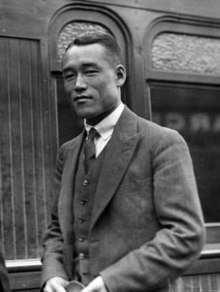Jiro Sato

Jiro Sato in 1932 at Central Station, Sydney
|
|
| Country (sports) |
|
|---|---|
| Born |
January 5, 1908 Gunma Prefecture, Empire of Japan |
| Died | April 5, 1934 (aged 26) Strait of Malacca |
| Turned pro | 1929 (amateur tour) |
| Retired | 1934 (due to death) |
| Plays | Right-handed |
| Singles | |
| Highest ranking | No. 3 (1933, A. Wallis Myers) |
| Grand Slam Singles results | |
| Australian Open | SF (1932) |
| French Open | SF (1931, 1933) |
| Wimbledon | SF (1932, 1933) |
| US Open | 4R (1933) |
| Doubles | |
| Grand Slam Doubles results | |
| Wimbledon | F (1933) |
| Mixed doubles | |
| Grand Slam Mixed Doubles results | |
| Australian Open | F (1932) |
Jiro Sato (佐藤 次郎 Satō Jirō?, Japanese pronunciation: [ˈdʑi.ɽo ˈsato]; January 5, 1908 – April 5, 1934) was a Japanese tennis player. He was ranked World No. 3 in 1933, but committed suicide in the Strait of Malacca during his trip to the Davis Cup in 1934.
He received worldwide fame in Wimbledon 1932, when he beat the defending champion Sidney Wood at the quarterfinal. In the semifinal, he lost to Bunny Austin. His peak came in 1933, when he beat Fred Perry in the French Open quarterfinal. He was ranked World No. 3 by A. Wallis Myers of The Daily Telegraph, behind Jack Crawford and Fred Perry. However, it got more and more difficult for him to endure the enormous pressure from Japan. It is believed that pressure drove him to throw himself overboard into the Strait of Malacca on April 5, 1934, at 26 years of age.
He debuted on the international tennis scene in 1929 when the touring Racing Club de Paris visited Japan for a series of exhibition matches. He notably defeated tennis legends Jacques Brugnon, Raymond Rodel and Pierre Henri Landry, only losing to Henri Cochet.
...
Wikipedia
